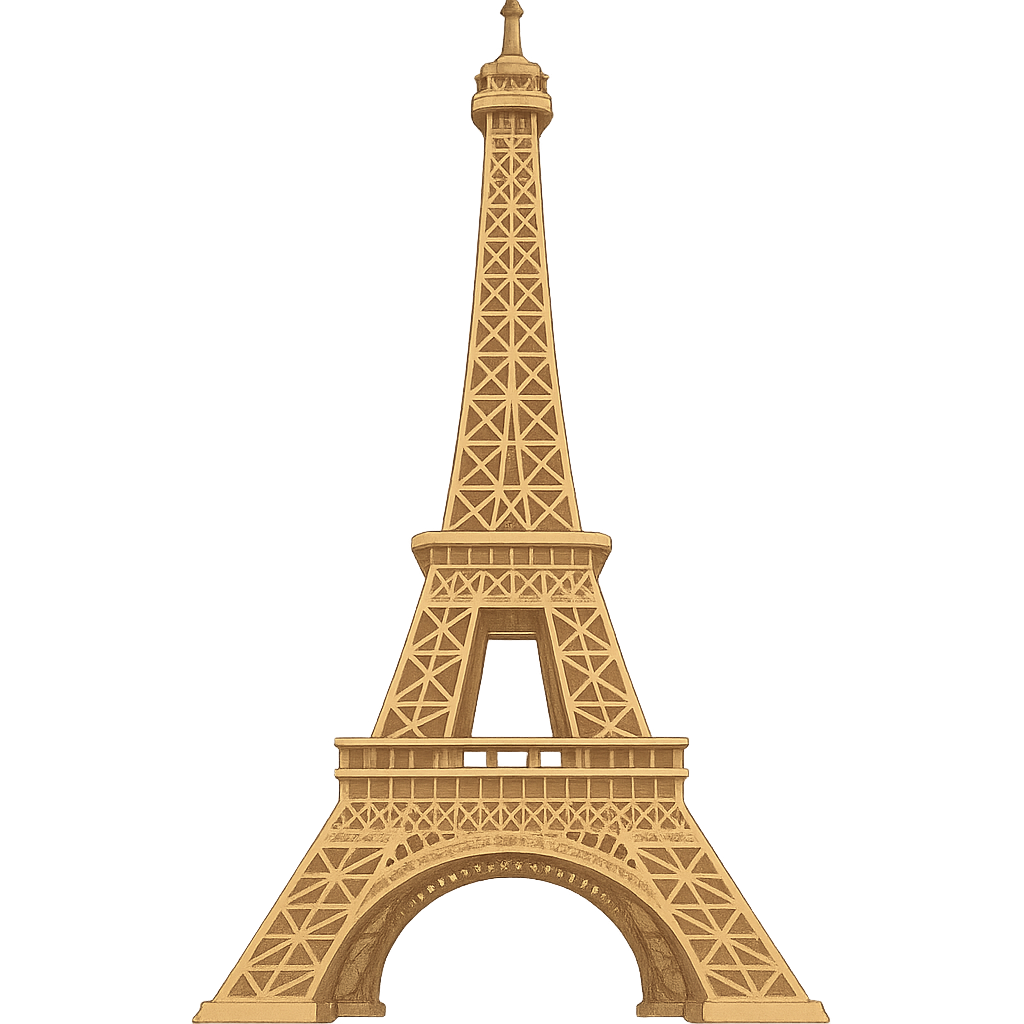The Iron Lady of Paris
I stretch toward the clouds, a giant made of intricate iron lace. The wind is my constant companion, whistling through my beams and trusses as I stand guard over a magnificent city. Far below, the River Seine snakes through the heart of Paris, a silver ribbon reflecting the sky. From my highest point, the city unfolds like a beautiful, living map, with grand boulevards, charming rooftops, and famous landmarks looking like tiny toys. By day, I am a bronze giant against the blue canvas of the sky. By night, I come alive, dressed in a glittering coat of 20,000 lights that sparkle every hour, sending a beacon of light sweeping across the rooftops. I hear the hum of traffic, the laughter from boats on the river, and the millions of voices that speak my name in every language imaginable. They call me the Iron Lady, a landmark of love and light. I am the Eiffel Tower.
My story begins with a grand party. In the late 1880s, France was preparing for a huge celebration called the 1889 Exposition Universelle, or World’s Fair. This event was incredibly important because it was planned to mark the 100th anniversary of the French Revolution, a time when the people of France fought for liberty and equality. The organizers wanted to create something spectacular, an entrance arch so magnificent it would leave the whole world in awe of France’s creativity and engineering skill. A competition was announced, and over 100 designs were submitted. The winning idea came from the company of a brilliant engineer named Gustave Eiffel. He and his team, including Maurice Koechlin and Émile Nouguier, were famous for building strong, elegant iron bridges. They proposed something that had never been done before: a tower made entirely of wrought iron, soaring higher than any structure ever built by human hands. It was a daring, almost unbelievable idea, but it captured the imagination of the judges.
My construction began on January 28, 1887, and it was like watching a massive puzzle being pieced together in the sky. My skeleton was made of 18,038 individual pieces of wrought iron, all carefully forged in a factory outside Paris. Each piece was designed with incredible precision, down to the millimeter, and brought to the site to be assembled. A team of brave workers, known as “sky-walkers,” climbed my growing frame, connecting the heavy beams with 2.5 million rivets. They worked high above the city with no modern safety nets, relying only on their skill and courage. But not everyone in Paris was excited. A group of famous artists and writers published a letter in the newspaper, calling me a “useless and monstrous” factory smokestack that would ruin the beauty of their beloved city. They saw me as a cold, industrial giant. This protest was a great challenge, but Gustave Eiffel believed in his vision. He knew that my form, dictated by the laws of physics to withstand the wind, had its own kind of beauty and strength. He was determined to prove my critics wrong.
On March 31, 1889, after just two years, two months, and five days of work, I was finally complete. Gustave Eiffel himself climbed my 1,710 steps to the top and proudly raised the French flag. At 300 meters tall, I was officially the tallest man-made structure in the world, a title I would hold for the next 41 years. When the World’s Fair opened, visitors were amazed. They rode my newfangled hydraulic elevators up to my viewing platforms and gasped at the breathtaking panorama of Paris. I was an instant sensation. But my future was uncertain. I was built to be a temporary attraction, and the plan was to tear me down in 20 years, in 1909. My fate seemed sealed until a new invention came along: the radio. Scientists discovered that my great height made me the perfect antenna for sending and receiving wireless signals. My purpose shifted from being a spectacle to being a vital tool for communication. I helped send the first transatlantic radio signals and played a crucial role in military communications during World War I. Science had given me a second life.
For over 130 years, I have stood tall, a silent witness to history. I have seen peace and war, celebration and sorrow. Today, I am more than just an iron tower; I am the heart of Paris, a symbol of France recognized all over the globe. Millions of people from every corner of the earth visit me each year. They climb my stairs, take photographs from my decks, and feel a sense of wonder as they gaze out at the city I call home. I am a backdrop for fireworks on Bastille Day, a beacon of hope in difficult times, and a place where countless dreams are born. My story is a reminder that a bold idea, even one that others might call impossible or ugly, can grow to become a lasting symbol of human creativity and resilience. So, look up at the sky, and dare to build your own dreams, no matter how tall they may seem.
Reading Comprehension Questions
Click to see answer
